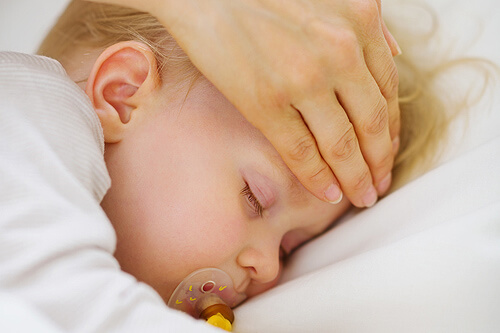Preventing Bronchiolitis: Is It Possible?

One of the most common questions about children’s health is whether or not preventing bronchiolitis is possible.
Both acute bronchitis and chronic bronchiolitis are often unavoidable. However, there are certain measures you can take to reduce the risk.
Bronchiolitis is a respiratory infection that has symptoms similar to those of a common cold. In babies and other vulnerable populations, however, it can lead to serious complications.
One in four doctor’s visits for bronchiolitis result in a hospital stay for the baby. For this reason, experts recommend visiting the doctor when cold-like symptoms get worse.
The symptoms of bronchiolitis in children are very similar to those of a cold. However, this illness is responsible for the largest number of hospital stays in young children.
Symptoms of bronchiolitis
As previously mentioned, the symptoms of bronchiolitis can be very similar to those of a common cold.
If your baby has cold-like symptoms which seem to be getting worse, it’s very important to go to the doctor and get the necessary tests done.
These are the main symptoms:
- Chest pain.
- A wet cough that produces mucus. If this is yellowish, it’s probably a bacterial infection.
- Fatigue.
- Fever, usually low.
- Difficulty breathing.
- Wheezing.

Other symptoms of chronic bronchiolitis are:
- Inflammation of the ankles, feet and legs.
- Bluish lips due to difficulty breathing.
- Recurrent secondary respiratory infections, such as colds or flu.
Tips for preventing bronchiolitis
To reduce the chances of your baby catching bronchiolitis, pay attention to their environment and surroundings.
Take care when people touch your baby and ensure good hygiene to prevent health problems.
These tips will be useful for preventing bronchiolitis:
- Before touching the baby, it’s very important to wash your hands, particularly when you’ve just arrived home.
- Wash cloth toys and wipe down surfaces and any other toys that are in contact with your child’s hands and mouth.
- Avoid tobacco smoke at all costs. It’s very important that nobody smokes in the house or around your child. The components of tobacco remain on surfaces and in fabric.
- If you’ve been out, change your clothes if you’ve been in a smoky environment.
- Another tip for preventing bronchiolitis is to ventilate the house every day. Also make sure it isn’t too hot or too cold.
- Avoid anywhere where your child may be at a high risk of catching the illness, such as hospitals, clinics and public transport, among others.
- Use disposable tissues wherever possible to avoid contagion.
- When you cough or sneeze, cover your mouth with your inner elbow, not your hand. Teach your children to do the same.
- Breastfeeding provides some resistance against bronchiolitis, so experts recommend breastfeeding until 6 months.
- Talk to your doctor about the possibility of vaccinating your child if they are in a high-risk group.

Treatment of bronchiolitis
There is no specific treatment for viral bronchiolitis, but there are some measures we can take to relieve the symptoms.
Antibiotics aren’t useful in this case: they treat infections caused by bacteria, not viruses. Some advice that you can follow includes:
- Use a nasal spray containing saline solution, following your pediatrician’s advice.
- Use a suction tube to unblock your baby’s nose. This works best for the first 6 months.
- Acetaminophen or paracetamol can help to reduce fever in children, but always consult your pediatrician before giving your child this or any other medication.
- It’s important that your baby gets plenty to drink. Also keep in mind that they lose their appetite due to difficulty breathing.
If you notice any cold-like symptoms that go on for more than a few days, it’s important to speak to your pediatrician to check for bronchiolitis.
One of the reasons why this illness can be so dangerous is that it often goes unnoticed until the moment when the child’s health is in serious danger.
One of the most common questions about children’s health is whether or not preventing bronchiolitis is possible.
Both acute bronchitis and chronic bronchiolitis are often unavoidable. However, there are certain measures you can take to reduce the risk.
Bronchiolitis is a respiratory infection that has symptoms similar to those of a common cold. In babies and other vulnerable populations, however, it can lead to serious complications.
One in four doctor’s visits for bronchiolitis result in a hospital stay for the baby. For this reason, experts recommend visiting the doctor when cold-like symptoms get worse.
The symptoms of bronchiolitis in children are very similar to those of a cold. However, this illness is responsible for the largest number of hospital stays in young children.
Symptoms of bronchiolitis
As previously mentioned, the symptoms of bronchiolitis can be very similar to those of a common cold.
If your baby has cold-like symptoms which seem to be getting worse, it’s very important to go to the doctor and get the necessary tests done.
These are the main symptoms:
- Chest pain.
- A wet cough that produces mucus. If this is yellowish, it’s probably a bacterial infection.
- Fatigue.
- Fever, usually low.
- Difficulty breathing.
- Wheezing.

Other symptoms of chronic bronchiolitis are:
- Inflammation of the ankles, feet and legs.
- Bluish lips due to difficulty breathing.
- Recurrent secondary respiratory infections, such as colds or flu.
Tips for preventing bronchiolitis
To reduce the chances of your baby catching bronchiolitis, pay attention to their environment and surroundings.
Take care when people touch your baby and ensure good hygiene to prevent health problems.
These tips will be useful for preventing bronchiolitis:
- Before touching the baby, it’s very important to wash your hands, particularly when you’ve just arrived home.
- Wash cloth toys and wipe down surfaces and any other toys that are in contact with your child’s hands and mouth.
- Avoid tobacco smoke at all costs. It’s very important that nobody smokes in the house or around your child. The components of tobacco remain on surfaces and in fabric.
- If you’ve been out, change your clothes if you’ve been in a smoky environment.
- Another tip for preventing bronchiolitis is to ventilate the house every day. Also make sure it isn’t too hot or too cold.
- Avoid anywhere where your child may be at a high risk of catching the illness, such as hospitals, clinics and public transport, among others.
- Use disposable tissues wherever possible to avoid contagion.
- When you cough or sneeze, cover your mouth with your inner elbow, not your hand. Teach your children to do the same.
- Breastfeeding provides some resistance against bronchiolitis, so experts recommend breastfeeding until 6 months.
- Talk to your doctor about the possibility of vaccinating your child if they are in a high-risk group.

Treatment of bronchiolitis
There is no specific treatment for viral bronchiolitis, but there are some measures we can take to relieve the symptoms.
Antibiotics aren’t useful in this case: they treat infections caused by bacteria, not viruses. Some advice that you can follow includes:
- Use a nasal spray containing saline solution, following your pediatrician’s advice.
- Use a suction tube to unblock your baby’s nose. This works best for the first 6 months.
- Acetaminophen or paracetamol can help to reduce fever in children, but always consult your pediatrician before giving your child this or any other medication.
- It’s important that your baby gets plenty to drink. Also keep in mind that they lose their appetite due to difficulty breathing.
If you notice any cold-like symptoms that go on for more than a few days, it’s important to speak to your pediatrician to check for bronchiolitis.
One of the reasons why this illness can be so dangerous is that it often goes unnoticed until the moment when the child’s health is in serious danger.
This text is provided for informational purposes only and does not replace consultation with a professional. If in doubt, consult your specialist.








